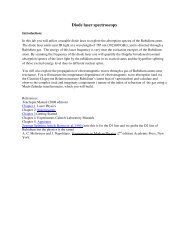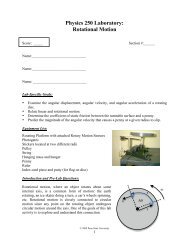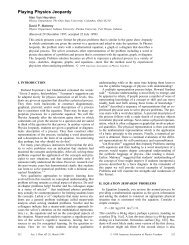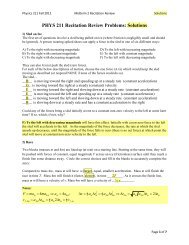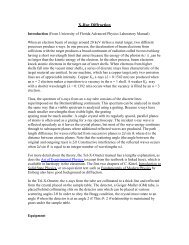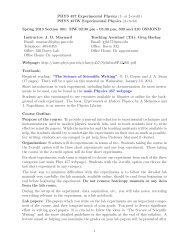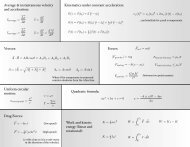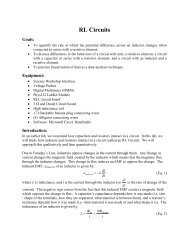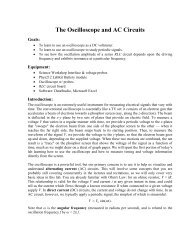optical
optical
optical
Create successful ePaper yourself
Turn your PDF publications into a flip-book with our unique Google optimized e-Paper software.
paring with the appropriate formula, the temperature T of the filament may be determined.<br />
By adjusting the electrical power delivered to the filament, different temperatures may be<br />
measured.<br />
(b) Using several values of T, the electrical power I dc V dc may be plotted versus T 4 , and the<br />
slope of a fitted line may be used to determine a value for σ B .<br />
Optical Absorbance by Light Sensitive Molecules and Beer’s Law<br />
The Beer-Lambert Law [?], more commonly known as Beer’s law, states that the <strong>optical</strong><br />
absorbance by a light-sensitive molecule (e.g., a dye molecule) in a transparent solvent varies<br />
linearly with both the sample cell path length and the concentration of the molecules in the<br />
solvent. In practice, Beer’s law is accurate enough for a range of light-sensitive molecules,<br />
solvents and concentrations, and is a widely used relationship in quantitative spectroscopy.<br />
Absorbance is measured in a spectrophotometer by passing a collimated beam of light at<br />
wavelength λ through a plane parallel slab of material that is normal to the beam. For<br />
liquids, the sample is held in a an <strong>optical</strong>ly flat, transparent container called a cuvette.<br />
Optical absorbance OA is calculated from the ratio of the spectral density transmitted<br />
through the sample ε ′ e (λ) to the spectral density that is incident on the sample ε e (λ) (with<br />
T = room temperature).<br />
ε ′ e (λ)<br />
OA = − log 10 (5)<br />
ε e (λ)<br />
For a sample with an <strong>optical</strong> pathlength l and a molar concentration C m [with units of<br />
molarity (M), defined as a mole per liter (mol/L)], Beer’s law can be stated as<br />
OA = α m (λ)lC m (6)<br />
where α m (λ) is the coefficient of molar absorptivity (also known as the extinction coefficient)<br />
of the molecule at wavelength λ. α m (λ) has units M −1 m −1 , and is a property of the material<br />
and the solvent.<br />
In an absorbance experiment, light is attenuated not only by the light-sensitive molecule<br />
but also by reflections from the interface between air and the cuvette, the cuvette and the<br />
sample, and absorbance by the solvent. These factors can be quantified separately, but<br />
are often removed by defining ε e (λ) as the light intensity passing through a sample blank<br />
or reference sample (e.g., a cuvette filled with solvent but with zero concentration of the<br />
light-absorbing molecule).<br />
In the optics lab, the transmitted spectral density ε e ′ (λ) of various samples with different<br />
concentration and the sample blank spectral density ε e (λ) are measured so as to determine<br />
the absorbance OA. By fitting the absorbance OA versus the concentration C m , which should<br />
have linear relation, Beer’s law may be verified. The measurements will be performed on<br />
solutions of two different dye molecules, indocyanine green (ICG) [?] and hexamethylindotricarbocyanine<br />
tetrafluoroborate (HITC-BF4) [?] solutions.<br />
6



